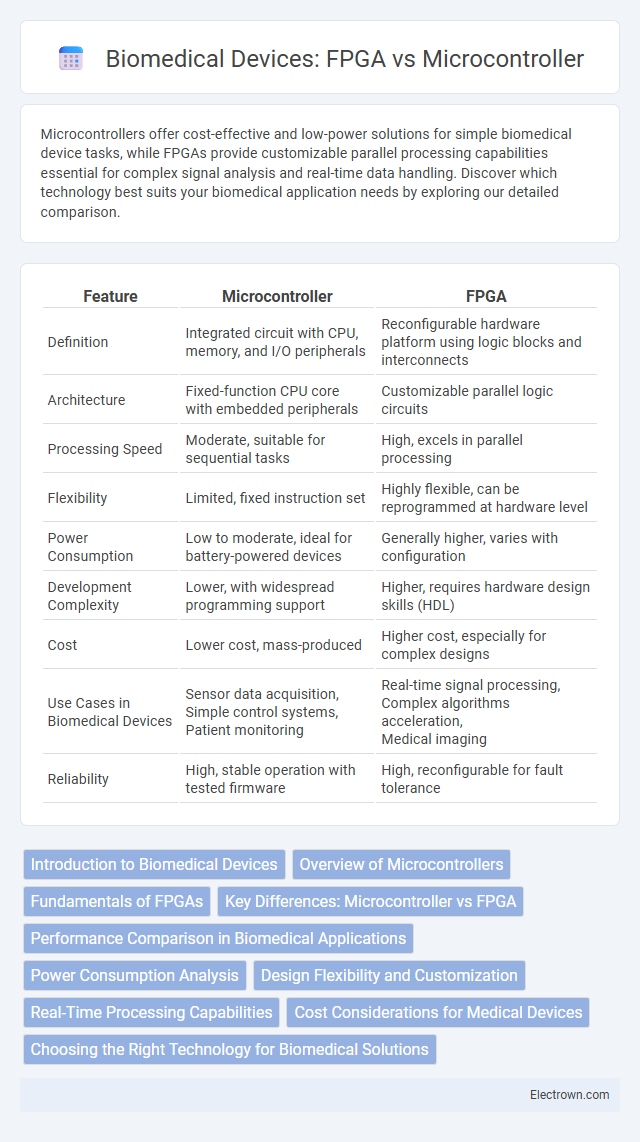Microcontrollers offer cost-effective and low-power solutions for simple biomedical device tasks, while FPGAs provide customizable parallel processing capabilities essential for complex signal analysis and real-time data handling. Discover which technology best suits your biomedical application needs by exploring our detailed comparison.
Table of Comparison
| Feature | Microcontroller | FPGA |
|---|---|---|
| Definition | Integrated circuit with CPU, memory, and I/O peripherals | Reconfigurable hardware platform using logic blocks and interconnects |
| Architecture | Fixed-function CPU core with embedded peripherals | Customizable parallel logic circuits |
| Processing Speed | Moderate, suitable for sequential tasks | High, excels in parallel processing |
| Flexibility | Limited, fixed instruction set | Highly flexible, can be reprogrammed at hardware level |
| Power Consumption | Low to moderate, ideal for battery-powered devices | Generally higher, varies with configuration |
| Development Complexity | Lower, with widespread programming support | Higher, requires hardware design skills (HDL) |
| Cost | Lower cost, mass-produced | Higher cost, especially for complex designs |
| Use Cases in Biomedical Devices |
Sensor data acquisition, Simple control systems, Patient monitoring |
Real-time signal processing, Complex algorithms acceleration, Medical imaging |
| Reliability | High, stable operation with tested firmware | High, reconfigurable for fault tolerance |
Introduction to Biomedical Devices
Biomedical devices rely on precise data processing and control, where microcontrollers offer programmable, cost-effective solutions with real-time capabilities for managing sensors and actuators. FPGAs provide parallel processing power and customizable hardware configuration, enhancing signal processing speed and flexibility in complex biomedical applications. Choosing between microcontrollers and FPGAs depends on the device's requirements for latency, complexity, and power efficiency.
Overview of Microcontrollers
Microcontrollers in biomedical devices serve as compact, integrated circuits designed to execute specific control tasks with embedded memory and processing units tailored for real-time operations. These units offer efficient management of sensors, signal processing, and actuator control, critical for monitoring physiological parameters and delivering therapeutic interventions. Their low power consumption, ease of programming, and cost-effectiveness make microcontrollers ideal for portable and wearable medical devices requiring reliable, deterministic performance.
Fundamentals of FPGAs
FPGAs (Field-Programmable Gate Arrays) offer customizable parallel processing capabilities essential for handling complex biomedical signal processing tasks with low latency. Unlike microcontrollers, which rely on sequential execution, FPGAs enable hardware-level customization, improving real-time data acquisition and analysis in devices like ECG monitors and wearable sensors. Your choice of an FPGA allows for adaptable and high-throughput operations critical in advanced biomedical applications.
Key Differences: Microcontroller vs FPGA
Microcontrollers in biomedical devices offer low power consumption and ease of programming, making them ideal for sensor data acquisition and simple control tasks. FPGAs provide customizable hardware parallelism and high-speed processing capabilities, essential for complex signal processing and real-time data analysis. Choosing between a microcontroller and an FPGA depends on Your device's performance requirements, flexibility, and power constraints.
Performance Comparison in Biomedical Applications
Microcontrollers offer efficient control with low power consumption, making them ideal for simple biomedical sensor interfacing and signal processing tasks. FPGAs excel in parallel data processing and real-time analysis, providing superior performance for complex biomedical imaging and neural signal interpretation. Your choice depends on the required processing speed, complexity, and power constraints of the biomedical application.
Power Consumption Analysis
Microcontrollers typically consume less power than FPGAs, making them suitable for long-term, battery-operated biomedical devices such as wearable health monitors. FPGAs offer higher performance and parallel processing capabilities but require significantly more power, which can limit their use in portable or energy-sensitive biomedical applications. Power-efficient FPGA architectures and dynamic power management techniques are being developed to bridge this gap, enhancing their applicability in biomedical signal processing tasks.
Design Flexibility and Customization
Microcontrollers offer straightforward programming and consistent performance for biomedical devices with fixed functionality, while FPGAs provide extensive design flexibility and hardware-level customization, enabling tailored signal processing and real-time data acquisition. Your choice between microcontroller and FPGA impacts the device's adaptability to evolving biomedical algorithms and sensor integrations. Leveraging FPGA architecture allows for parallel processing and reconfigurable hardware, essential for advanced diagnostics and personalized medical applications.
Real-Time Processing Capabilities
Microcontrollers offer reliable real-time processing capabilities for biomedical devices with fixed, well-defined tasks, ensuring low latency and predictable response times essential for patient monitoring systems. FPGAs provide superior parallel processing performance, enabling complex, high-speed signal processing and customization for advanced diagnostics and imaging applications. Your choice depends on the need for flexibility and processing power, with FPGAs excelling in handling multiple data streams simultaneously while microcontrollers are optimal for simpler, power-efficient real-time control.
Cost Considerations for Medical Devices
Microcontrollers typically offer lower initial costs, making them suitable for budget-sensitive biomedical devices with standardized functions. FPGAs incur higher upfront expenses due to complex development and hardware costs but provide flexibility and customization for advanced medical applications requiring precise signal processing. Your choice depends on balancing cost constraints with the need for performance and adaptability in medical device design.
Choosing the Right Technology for Biomedical Solutions
Microcontrollers offer simplicity, low power consumption, and cost-effectiveness, making them ideal for basic biomedical devices such as portable monitors and wearable sensors. FPGAs provide parallel processing capabilities and high flexibility, enabling advanced real-time data analysis and custom signal processing vital for complex biomedical imaging and diagnostics. Your choice depends on device complexity, processing speed requirements, and the need for customization in biomedical solutions.
Microcontroller vs FPGA in Biomedical Devices Infographic

 electrown.com
electrown.com